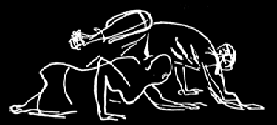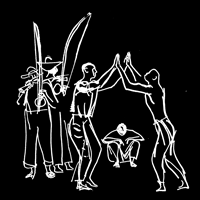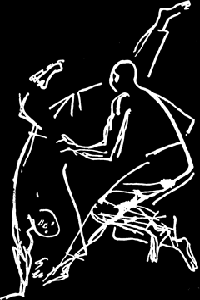
What
is Capoeira Angola?
Capoeira is an art form that weaves together fighting, dance,
music, ritual and philosophy into a unique "game" called the
jogo de Capoeira (play of Capoeira). While there is much dispute
over the exact origins of Capoeira, it is known that it was created
by African slaves in Brazil. Capoeira is a synthesis of various African
and Brazilian cultural and martial influences. As a martial art, Capoeira
uses primarily kicks, elbows and knees, headbutts, sweeps and takedowns
in a style that places emphasis on deception, flexibility and fluidity.
Direct force is primarily dealt with through evasion and timing. Rather
than block every attack your opponent throws at you, the goal is to
flow with their movement until the right moment of timed attack. In
Capoeira Angola, many of these movements begin from stances that
are low to the ground in an intricate game characterized by deceptive
ground movement, the strategic use of strikes and dynamic acrobatics.
As a game, the action is continuous, exciting and beautiful as both
players strive to outmaneuver each other. The creativity expressed in
this freestyle allows one to develop both the physical and mental aspects
inherent in conflict and acts as form of developing our reactions to
it.

As a cultural art form, Capoeira was a means of ensuring that the African
traditions would survive under harsh slavery. With movements and dance
that share much in common with certain African dances such as n'golo
from Angola, music using traditional African instruments such as the
Berimbau and the continuation of oral storytelling tradition,
Capoeira was a form of revolution in itself. In time, these qualities
adapted
with the slaves' new landscape to become a uniquely Afro-Brazilian art
that has continued to evolve throughout the years.

This
evolution has endured slavery, fierce political oppression that continued
after the ban on slavery and rifts within the Capoeira community itself.
These rifts were caused by the creation of separate styles of Capoeira,
primarily Regional and Angola. Regional is a newer
form which was created in the 1930s' by Mestre
Bimba. It is defined by a more aggressive
game which is played to fast rythmns which are meant to channel the
spirit of the fight. While Regional certainly developed new and
unique innovations to both the training and technique of the game- sequences-
and increased its' popularity, there was also a deemphasis on certain
traditions and rituals of the game. This was a trend which had continued
for many years until the resurgance of Capoeira Angola, the traditional
style which existed before Bimba. Kept alive by Mestre
Pastinha
who opened his school in 1941, Angola contributed to the
renewed interest in a more complete version of Capoeira's traditions,
rituals and history. Many schools now draw from both traditions to complete
their understanding of the art. Truthfully, there have always been various
styles of Capoeira which have existed and the art has always kept changing,
but no matter which style or variation is played, they draw on the same
elements.

The jogo(game) takes place in a circle called the roda
made up of the players and audience. Central to the roda and the practice
of Capoeira is the music, which is made up of the bateria(orchestra).
The bateria consists of three berimbau(stringed bow-like
instruments), pandeiros(tambourines), an agogo(bell),
a reco-reco(small bamboo instrument) and an atabaque(drum).
Once the roda begins, the players begin by singing a ladainha,
a ritual song of commencement, then a corrido, a call and response
type of song, which is passed on to the musicians and played for the
rest of the game. The music of Capoeira serves many purposes from commenting
on, as well as controlling the action within the roda to teaching rythmn
and timing to Capoeristas while inspiring the players. It is only when
both the music and movements are combined that one begins to feel the
true essence of Capoeira.